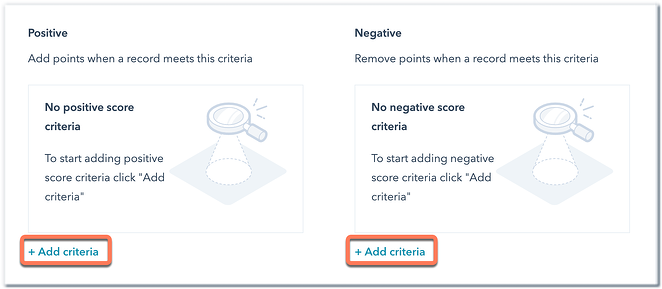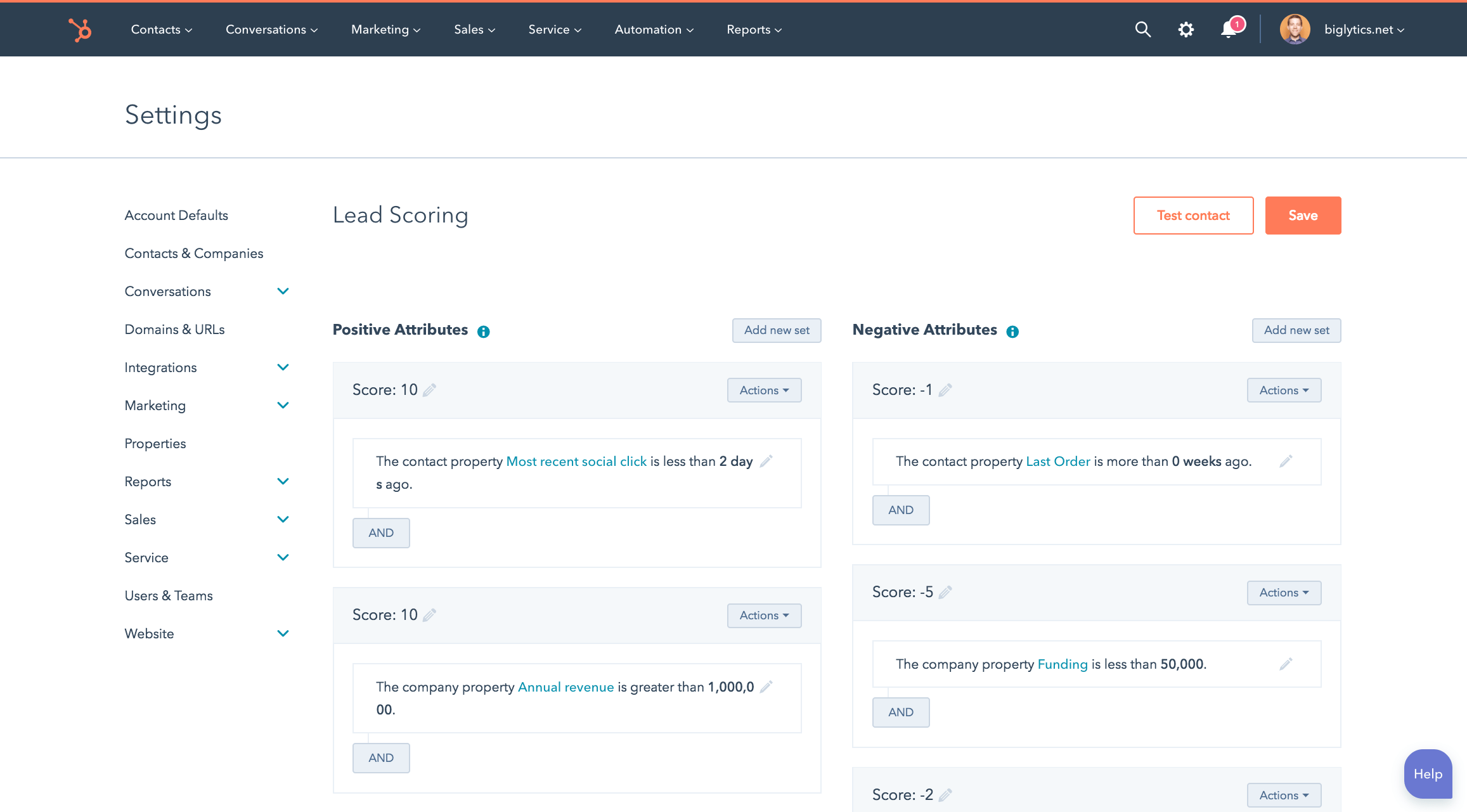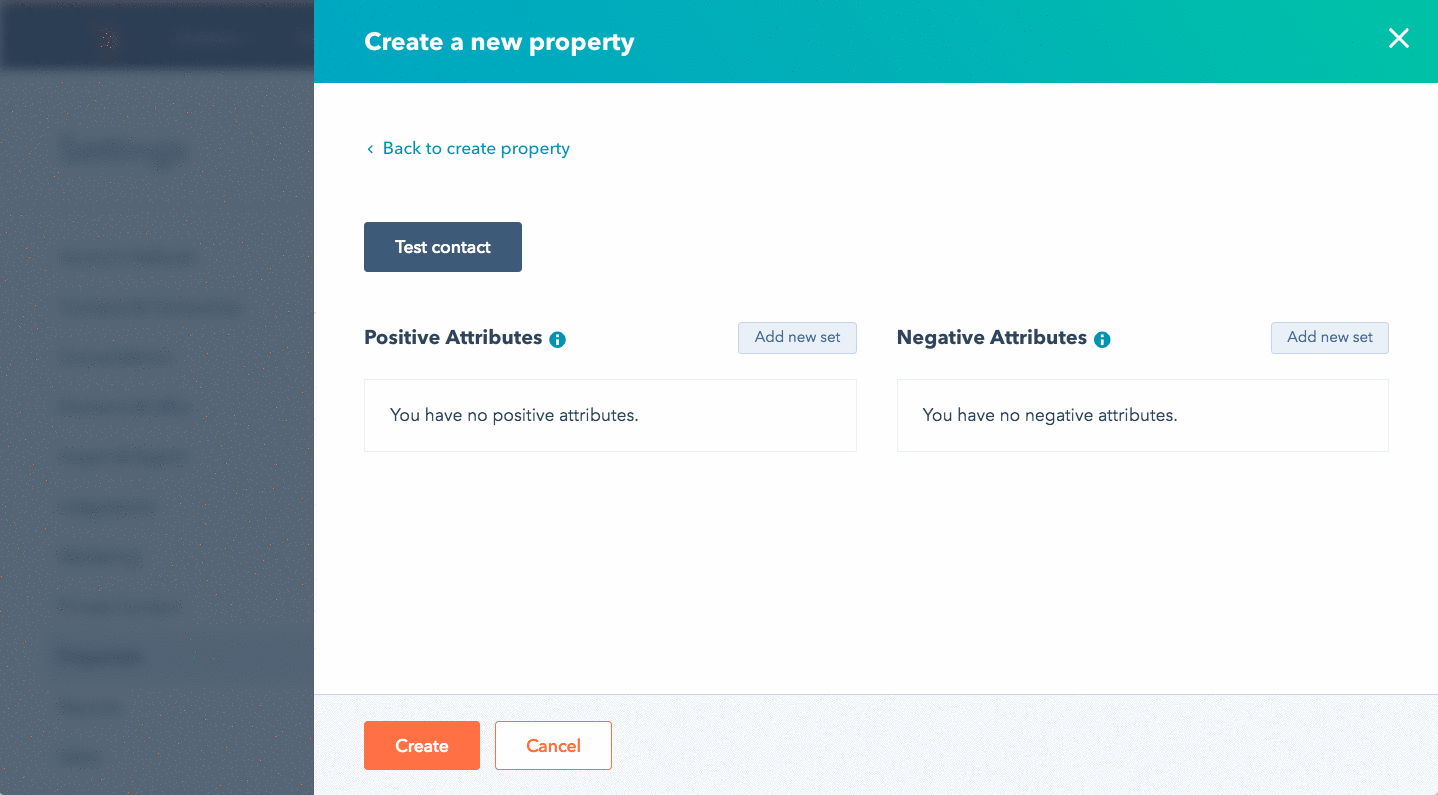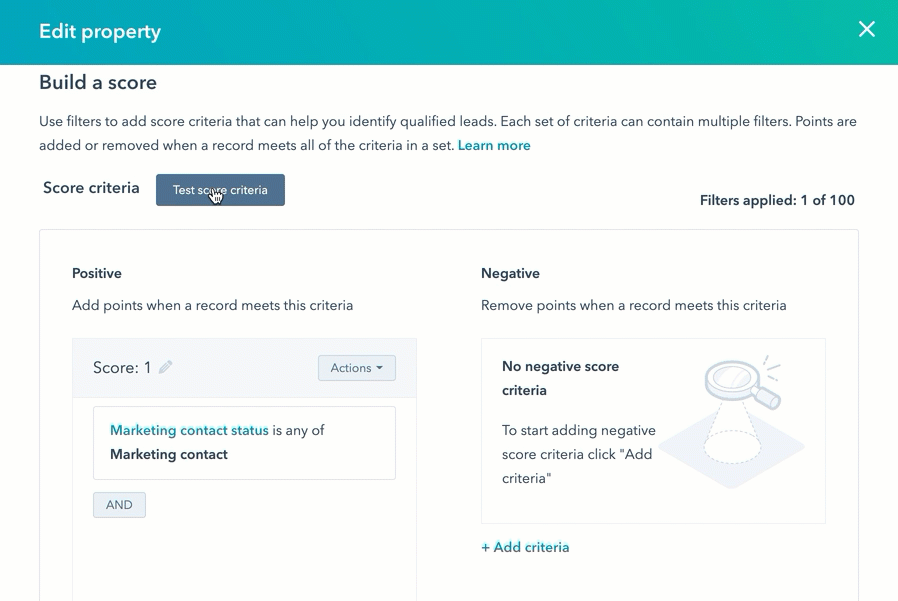How Lead Nurturing With HubSpot's Can Grow Your Business
In this blog post, we're going to take a look at HubSpot lead nurturing capability, a leader in customer relationship management (CRM) and marketing...
Improve your HubSpot Lead Scoring Strategies. The What, How and Why Guide of Lead Scoring
Are you tired of spending valuable time chasing after leads that never seem to convert? Do you wish you could focus your sales and marketing efforts on the most promising leads but struggle to identify which ones are worth pursuing? If so, you're in the right place!
In today's competitive business landscape, efficiently managing leads is crucial for success. Enter HubSpot lead scoring—a game-changing solution designed to revolutionise your lead management strategy. This powerful tool not only helps increase sales and improve your marketing ROI but also ensures your team focuses on the leads most likely to convert.
In this blog post, we'll dive into the ins and outs of lead scoring, exploring its numerous benefits and providing practical tips to make the most of this robust feature. You'll learn how to prioritise follow-ups, optimise your marketing campaigns, and ultimately, close more deals. So, buckle up and get ready to transform your business with HubSpot lead scoring!
Lead scoring is a methodology used by sales and marketing teams to assign a numerical value or score to each lead based on various criteria, such as demographic information, online behaviour, engagement with marketing materials, and their position in the buyer's journey. This score represents the lead's potential to become a customer and will influence how the follow-up is conducted—such as immediately handing the lead over to sales for outreach or determining which marketing strategies will best nurture the lead further.
The primary purpose of lead scoring is to help businesses prioritise their leads, focusing their efforts on those most likely to convert into customers. By identifying high-potential leads, teams can allocate their resources more effectively, ensuring timely follow-ups and targeted marketing campaigns. This approach ultimately leads to increased sales and improved marketing ROI.
To start scoring leads, you can assign a lead score between 1 and 100 based on fit and engagement with your company. For instance, if you have ten criteria, you could potentially score each one from 1-10 and add up the totals to get a percentage out of 100.
By implementing an effective lead scoring system, you can better qualify your leads and prioritize your efforts, ultimately resulting in more efficient and effective sales and marketing strategies.
Why use Lead Scoring in your business?
By implementing lead scoring, you can concentrate your efforts on the most promising leads, improve sales and marketing collaboration, and achieve higher conversion rates. This targeted approach will enhance your overall marketing effectiveness and boost your return on investment. Implement lead scoring and watch your efficiency, team collaboration, and revenue generation reach new heights by using HubSpot's lead scoring system. It's time to supercharge your sales and marketing strategies with data-driven decisions.
Focus on high-potential leads and maximise the effectiveness of your follow-ups and nurturing efforts. Stop wasting time on low-quality leads and see your conversion rates soar.
Empower your sales team to concentrate on high-quality leads, increasing productivity and driving sales success.
Foster better collaboration between your sales and marketing teams with a shared understanding of what makes a qualified lead. Work together to achieve your business goals.
Craft targeted and bespoke marketing campaigns that resonate with each lead segment, boosting your chances of conversion.
Identify promising leads that aren't quite ready to buy and engage them with tailored content and follow-ups until they're primed to make a purchase.
Enhance conversion rates and enjoy a higher return on investment by focusing on high-quality leads and delivering laser-focused marketing campaigns.
Simplify the process of evaluating and prioritising leads, making it easy to identify high-potential prospects and direct your resources effectively.
Utilise lead scoring insights to create bespoke, targeted campaigns that resonate with different lead segments, increasing conversion chances. This allows you to fine-tune your HubSpot campaigns so they're more effective at converting leads into customers.
How to Score Leads?
Lead scoring is a crucial process for prioritising leads and ensuring that sales and marketing efforts are focused on the most promising prospects. Here’s a step-by-step guide on how to score leads effectively:
Start by determining the characteristics and behaviours that are most indicative of a high-quality lead. Common criteria include:
Demographic Information:
Behavioural Data:
Engagement Metrics:
Sales Interaction:
Create a point system for each criterion. Assign higher points to actions and attributes that indicate a stronger buying intent or a better fit with your ideal customer profile. For example:
Group the total scores into tiers that represent the lead’s potential value. For example:
This tier system helps your team quickly identify which leads to prioritise.
Use CRM software, such as HubSpot, to automate the lead scoring process. Automation ensures that scores are updated in real-time based on lead interactions and attributes, maintaining accuracy and efficiency.
Continuously evaluate and refine your lead scoring model to ensure it remains effective. Gather feedback from your sales and marketing teams and analyse conversion data to make necessary adjustments.

HubSpot Lead Scoring is a powerful feature that allows businesses to rank their leads based on their likelihood to convert into customers within the HubSpot platform. The more points a lead has, the more likely they are to become a customer. This process involves assigning a numerical value or score to each lead based on various criteria such as demographic information, online behaviour, engagement with marketing materials, and their position in the buyer's journey. Here’s how to effectively use HubSpot Lead Scoring:
The lead scoring tool provided is designed to help you swiftly and effortlessly score your leads by attributing a numerical value to each lead, using specific criteria to determine which leads are the most qualified. The criteria employed for scoring leads will vary depending on your business and what you consider essential. Some common sales factors often used include budget, authority, need, timeline, and levels of engagement. Some common marketing factors often include buyer journey stage, the number of interactions they've had with your brand.
To utilise HubSpot lead scoring, businesses must first identify their target customers. After establishing customer personas, they can create lead scores for each persona, assigning points based on their buyer journey stage and interactions with the brand. For instance, if targeting small businesses, you might allocate 10 points for leads in the awareness stage and 20 points for those in the consideration stage. The system operates by assigning points to leads according to their stage in the buyer journey, the number of interactions they've had with your brand, and other relevant factors.
Start by determining the characteristics and behaviours that are most indicative of a high-quality lead. Common criteria include:
Demographic Information:
Behavioural Data:
Engagement Metrics:
Sales Interaction:
Create a point system for each criterion. Assign higher points to actions and attributes that indicate a stronger buying intent or a better fit with your ideal customer profile. For example:
Group the total scores into tiers that represent the lead’s potential value. For example:
Ultimately, the goal of HubSpot lead scoring is ultimately to help businesses prioritise follow-ups so they can close more deals.'
Here are some tips for using HubSpot lead scoring to get the most out of it:
Define your ideal customer profile (ICP):
Before you start scoring leads, determine your ICP by identifying the characteristics of your best customers, such as company size, industry, and revenue. This will help you create relevant lead-scoring criteria and focus on high-potential prospects.
Ideal customer: What is the minimum criteria a lead must pass to become a customer?
Current customer: What qualities do your current customers have in common?
Customer journey: What does a successful customer journey look like?
Sales cycle: How long is the sales cycle of a valuable lead vs. a low-scoring lead?
Lifetime value: What is the lifetime value or average spend of a valuable lead?
Create Persona's
Personas could include groups such as affluent individuals, decision makers in companies, or graduates from specific fields of study, among many other criteria. As you can see, plenty of options! It’s simply a matter of what works best for you.
Start with basic criteria:
When setting up lead scoring, begin with basic criteria such as demographic information (e.g., job title, company size), behavioural data (e.g., email opens, website visits), and lead source. As you gain more insights, you can refine your criteria for better lead prioritisation.
Use both positive and negative scoring:
Assign positive points for factors that indicate a lead is more likely to convert, and negative points for factors that suggest they may not be a good fit. This will help you differentiate between high-quality leads and those less likely to convert.
Monitor and adjust scores:
Regularly review your lead scores and adjust the criteria based on the performance of your leads. Keep an eye on trends, and modify the scoring system as needed to ensure it stays relevant to your evolving sales and marketing strategies.
Collaborate with sales and marketing teams:
Work closely with your sales and marketing teams to ensure everyone understands the lead scoring system and its goals. This collaboration will help both teams align their efforts and focus on the most promising leads.
Automate lead scoring:
Take advantage of HubSpot's built-in lead scoring tool, which will automatically assign scores to new leads as they're added to your CRM. This saves time and ensures a consistent scoring process.
Segment leads based on scores:
Lead scoring works best when it's used in conjunction with lead segmentation. By segmenting your leads into distinct groups, you can target each group with specific marketing messages. This will help you convert more leads into customers. Group leads with similar scores and create targeted marketing campaigns for each segment. This will help you deliver personalised content and improve the effectiveness of your marketing efforts.
Consistent Testing and Refinement:
Regularly assess and improve your lead scoring system to increase its accuracy and effectiveness. Align the criteria with your sales and marketing objectives.
Adapt Lead Scores as Business Evolves:
Modify lead scores according to your business's growth and changes, such as targeting new customer personas or removing obsolete criteria.
Regular Reviews of Lead Scores:
Ensure the accuracy and relevance of your lead scoring system by reviewing lead scores frequently.
Determine your ideal buyer persona:
Adjust your campaign strategy and targeting to focus on generating quality leads that fit your sales team’s focus.
Ensure your sales and marketing teams are aligned
Both teams should be aligned on what constitutes a marketing qualified lead (MQL). This way you can devise an appropriate lead scoring strategy to ensure that you can focus on providing the right quality and quantity to the sales team.
By following these tips, you can optimise the use of HubSpot lead scoring in your business, enhancing marketing efforts and boosting sales conversions.
In the fast-paced world of digital marketing, effectively managing and prioritising leads is crucial for success. HubSpot lead scoring offers a transformative approach that can revolutionise your lead management strategy, boost sales efficiency, and enhance marketing ROI. By assigning numerical values to your leads based on their likelihood to convert, you can ensure that your sales and marketing teams focus their efforts on the most promising prospects.
Implementing lead scoring allows you to prioritise high-potential leads, enabling your teams to conduct timely follow-ups and targeted marketing campaigns. This targeted approach not only improves conversion rates but also fosters better collaboration between your sales and marketing teams, aligning their efforts towards common goals.
With HubSpot lead scoring, you can craft personalised marketing campaigns that resonate with each lead segment, nurture leads more effectively, and enjoy a higher return on investment. Regularly reviewing and refining your lead scoring criteria ensures that your system remains accurate and effective, adapting to the evolving needs of your business.
Embrace the power of HubSpot lead scoring to streamline your lead management process, make data-driven decisions, and ultimately drive your business growth. The future of your sales and marketing success is just a few clicks away. Start leveraging HubSpot lead scoring today and transform the way you approach lead management.
If you want to learn more about HubSpot Marketing, check out our HubSpot Marketing Hub Guide
In this blog post, we're going to take a look at HubSpot lead nurturing capability, a leader in customer relationship management (CRM) and marketing...
Learn how to maximise your advertising strategy with LinkedIn Ads & HubSpot CRM integration. Increase Leads and Improve Lead Quality to get a better...
The benefits of HubSpot Lists. Learn how to use them, when, why and how to get the best results with them
Be the first to know about new HubSpot nsights to build or refine your business with the tools and knowledge of today’s best practises.